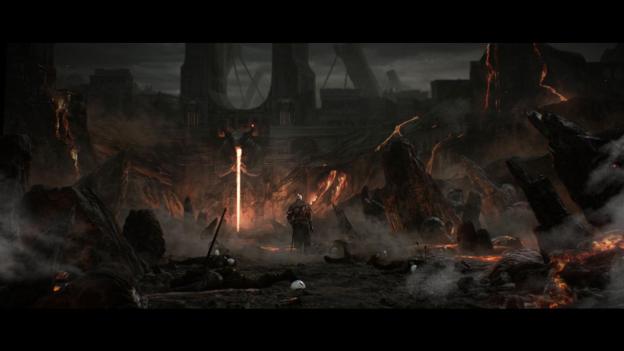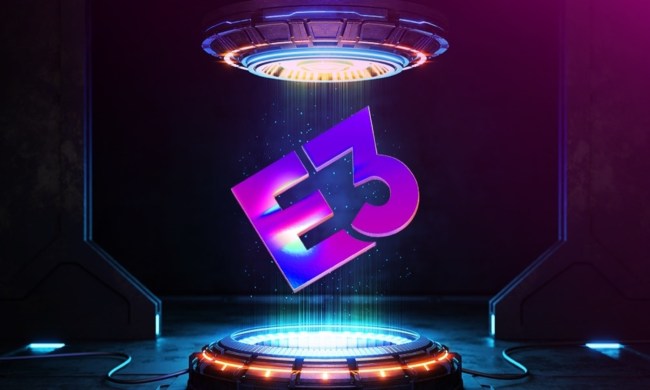
Check out our review of Dark Souls II.
During a recent Dark Souls II hands-on demo, death came early and often. After surviving a difficult and oft-repeated section filled with numerous retries, a sorcerer began casting a spell. Four statues stood up slowly, stretched, and turned, with murder in their eyes.
Beleaguered by two types of magic projectiles, one slow with moderate homing properties and the other quick like the classic Soul Arrow, beating a hasty retreat into a narrow hallway while pursued by the massive stone knights was the only option. They were surprisingly agile, with strange attack patterns that made them difficult to predict. A fight in the confines of the bonfire room was hopeless. That first death brought a smile and a rush of adrenaline, and I tried again.
Story/Concept
That familiar, hopeless feeling. The demo took place in Fort Resistance. It’s unclear where that moniker originates, but the fortress certainly resists attempts to be traversed. Up a small flight of stairs, weathered stone knights knelt in deference on either side of a narrow path through a lengthy, arching hall. At the end, a sorcerer wearing tattered robes and a headdress topped with a dozen or so curling ram’s horns (or maybe that was just its head) waited menacingly.
The story in Dark Souls II revolves around a cursed character seeking a cure. It will be connected to the previous entry, but it isn’t clear how quite yet, or where exactly this section fit in. This preview did little to clarify the narrative, but story always takes a backseat to the gameplay in a Souls game.
Gameplay
If at first you don’t succeed… Dark Souls is not about achieving greatness on the first try, or the fifth. It’s about persevering no matter how many tries it takes.
For the demo, the knight you’ve seen in the trailer was playable; a magic-wielder was also available. A character that looked like a Faith-based knight and one that specialized in dual-wielding were visible, but not playable for this demo. The knight had a shield, a bow, and two swords, one huge, unwieldy and powerful, the other smaller, delivering more rapid but less damaging strikes.
The highlight (and most challenging part) came during a boss battle with a large, armored foe called the Mirror Knight. It fits with a familiar motif: this large, armored foe, visor down, could be a demon, or a giant, or something else entirely. But its man-sized, mirrored shield and lightning-based attacks set it apart from similar past enemies.
It leapt through the air and shot lightning from its fists. Surviving longer than ten seconds into this battle (easier said than done) revealed the boss’s trump card: it set its mirrored shield on the ground, a blurry image of a knight forming on the metallic surface. The reflection broke the shield from the inside out and joined the fray, and their double assault proved too difficult to defeat.
Returning hits. Much about Dark Souls 2 felt familiar. Bonfires return and still provide a respite, and recharge your health-giving Estus flask. Light, heavy, two-handed, and leaping attacks; all present. Dodging and rolling, leaping aside at the last second, getting quick jabs and swings in where you can; check. The patterns were the same.
But there were unique quirks and differences, too. Estus is back and works much the same, but your health won’t regenerate instantly when you drink it; the red bar at the top of the screen takes slightly longer to fill back up, leaving you vulnerable for a few extra, precious seconds.
Bug or feature? During my demo, attacks meant to be aimed at locked-on enemies unfortunately didn’t always go in the intended direction; attempting to strafe would sometimes cause an overhead swing to go off to the side, despite targeting an enemy directly ahead. This caused more than one death, and if it’s a feature and not a bug, it will take some getting used to.
And the new. Some welcome changes: the ability to shoot arrows and use some items while moving. The result is a greater feeling of mobility, especially when using new non-Estus health recovery items while retreating from enemies. A few extra steps can make all the difference. Further, characters (player and enemy alike) seem to now be vulnerable during animations that, in past games, caused them to go temporarily invincible.
That wasn’t always the case, but the knight, for example, could be damaged while lifting himself off the ground after being knocked down. But it also could work to your advantage as the statue enemies can be harmed while they were still getting up, and in fact were even more vulnerable in that state.
Presentation
Shadow and light. Passing through the fog gate behind the sorcerer, you enter a ruined courtyard ringed by crumbling columns, a storm raging in the dark sky above. Like the rest of the demo, it was gorgeous, the graphics a noticeable, if not exactly groundbreaking, step up from Dark Souls.
While the controls haven’t changed since Dark Souls, some animations seem more elaborate now, as well. This will surely alter the gameplay as some stronger attacks take even longer to complete than in past games, leaving you more vulnerable as you recover.
Gaming the System. Enemies in the Souls games haven’t always proved to be especially bright, and it looks like the same will prove true in Dark Souls 2. Using a bow to attack spell-throwing foes is a necessary tactic, but they will often make no move to close the distance or attack. In fact, the sorcerer in the demo seemed not even to notice the steady rain of arrows peppering its horned head.
It’s a familiar and cheap tactic for Souls players, but one that you’d hope would be removed from the sequel. In a game this difficult, most will take any advantage presented, but it’s better to win the old-fashioned way than cheat the system’s silly artificial intelligence.
Takeaway
There’s been some worry over Dark Souls 2. After an interview with the series’ new director suggesting the sequel could head in a more accessible direction, fans fretted that it would be too easy, even dumbed down. Judging by this E3 demo, however, it seems those fears can be put to rest.
From Software created masterpieces with Demon’s Souls and Dark Souls, and though series creator Hidetaka Miyazaki is not directly involved with Dark Souls 2, the Japanese studio may very well do it again.






